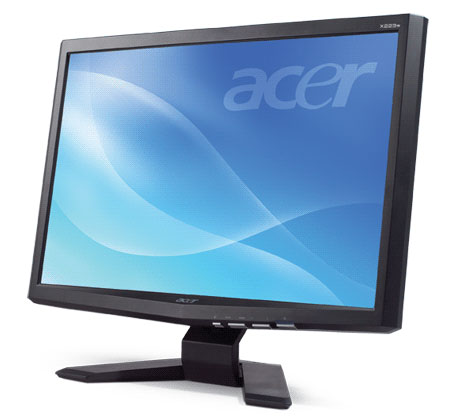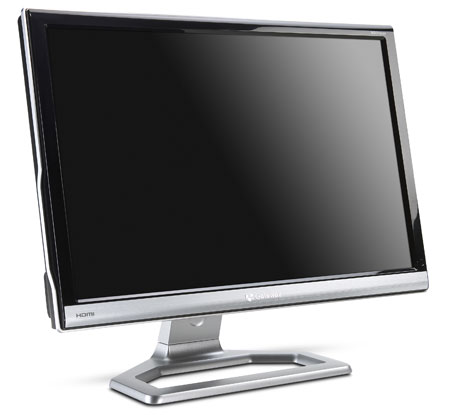Sub-$200 Options

There are plenty of options under $200 these days, but we tend to have a philosophy of "go big or go home" when it comes to LCDs. Do you really want to get a slightly better quality 19" LCD when $20 more will get you a 22" LCD? We certainly don't, and thus our recommendation ends up going to one of the many 22" LCDs currently priced under $200. Acer is more of a value brand in the LCD market, but that doesn't mean the LCDs aren't good. In fact, other than flimsy base stands we've never had a complaint with any of the Acer LCDs we've used. Specifications are pretty much meaningless at this price point -- all of the 22" LCDs that cost under $200 will be very similar, i.e. TN panel, 1680x1050, 5ms response times, HDMI and/or DVI -- so it really comes down to price and availability. Acer is a global company so their products are available around the world, and their prices are also very good. The Acer X223Wbd won't be the best LCD around, but for only $170 it's hard to complain. It is missing HDMI support, however, so if that's important we would recommend the ASUS VH226H, which also happens to bump up the resolution to 1920x1080 and only costs $40 more.
$200-$400 Recommendations

Not surprisingly, this is by far the largest category in terms of the available options. You can get everything from good quality 22" LCDs (or 20" S-IPS LCDs) up to and including 28" monsters of somewhat dubious quality. If the latter catches your fancy, check out the Hanns•G HG-281DPB at Newegg, currently going for only $380. Yes, that's less than most 24" LCDs, so we wouldn't expect best in class performance. What would we actually recommend? 22" offerings are going to be slightly better in terms of features and quality, but we would recommend going for a 24" LCD. Our overall recommendation goes to the Gateway FHD2401, a slight update to our Bronze Editors' Choice FHD2400 that uses a matte panel instead of a glossy panel. You still get a plethora of input options, and one of the best base stands that we've ever used.
If you're still looking for other alternatives, Dell has recently launched their 23" SP2309W that has a native resolution of 2048x1152 -- yes, higher than 1080P. We actually think 1080P movies will look best on 1080P displays, but for Windows work a slightly higher resolution might be useful. You still get a TN panel, and the price is quite a bit higher than 22" 1080P LCDs at $380. Acer once again shows up with the X243Wbd for $290, and we also have the BenQ E2400HD that we recently reviewed, now at $330. We wouldn't call the BenQ E2400HD perfect, but honestly for the price it's very good, especially if you never intend on using it at anything other than the native 1920x1080 resolution -- and we always recommend using native resolution on any LCD. Its "younger brother" E2200HD should also be available shortly, with a price in the low to mid $200 range.










50 Comments
View All Comments
silvajp - Wednesday, December 31, 2008 - link
In our home we went with a 25.5" from Samsung, native resolution 1920x1200. It's larger pixels were much easy on our eyes compared to a highly recommended 24" from Dell offering the same resolution.silvajp - Wednesday, December 31, 2008 - link
FYI We have the Samsung 2693HM.Also note this model seems to our eyes very bright and colorful. In fact one of us is a Graphic Artist and find the color range very satisfactory.
kondor999 - Saturday, December 27, 2008 - link
As someone who was very confused about the "Contrast Ratio War" going on in Retail, this was super-informative.I'll officially stop perseverating on this meaningless spec now.
gochichi - Tuesday, December 23, 2008 - link
Dear Anandtech,This is your job. It is truly disappointing to see so little help coming from the review sites. Dell has 31 LCD monitors. That's one brand, one brand that has some of the best LCDs and surely must have some bad ones too.
I've never seen a review of Dell's new high-RES 23" LCD. You guys mention it in passing. You guys also throw Acer a bone as an "overall good value", if you've never seen it, I certainly have. I purchased a 24" Acer LCD and returned it the next day. I preferred my old 17" MAG LCD (OLD! REALLY OLD!) to the junkiness of that Acer.
I currently have a 24" LCD, a 17" LCD, a 21.5" LCD, a 32" 720P HDTV (as a computer monitor) , and I totally disagree with your assumption that bigger is better (it's not worse either)because most of the monitors you mentioned are below $500.00, they are all affordable. Some other criterion must be used.
I think most people don't need as much help with the obvious things such as size. I don't need you to tell me that you prefer 24" screens, different sizes have different uses OBVIOUSLY. Can you instead tell me about the non-obvious, the performance, and so on?
Because I would absolutely be interested in a high performing 17" LCD as well as a high performing 20", etc. etc. The brick and mortar stores are little help, 90% of the time they have useless setups with the resolutions garbled up.
Every single Acer monitor I've seen I strongly dislike because of the image quality. Yet I've seen some very nice monitors in other sizes that I'd be happy to own, though I don't know the model numbers there are 4:3 ratio smaller Dells that are a pleasure to work on. (17" or 19" both).
Obviously, it's absurd that Dell has decided to release 31 models of LCDs, and that every other manufacturer does similar things. Samsung is not much better, they have 20" models, 21.5" models, 22" models many of which (most of which really) are impossible to differentiate from one another.
You guys could take a leadership role on this and really start untang ling this mess. Instead of this obscure, incomplete, biases guide (you yourselves called it biased, you said "bigger is better"). What are the 17" LCDs to look for? What are the 19" LCDs to look for? Etc etc.
Even more importantly is, which models should we avoid? But then again, I'm not exactly trusting your judgment too much since the only brand that received a blanket endorsement (Acer) is one of the very worse in my personal experience.
Other ways to divide LCD monitors: Glossy vs matte displays. From time to time I see glossy desktop displays and some of them are good, some of them not so much. For example HP's 20" glossy display is high quality. I would even appreciate a list of the brands and models that offer glossy displays (e.g. Dell's coating would be "TrueLife")as well as overall impressions on this.
I think my job is to come here, click on Ads and buy stuff and I do that. Your job is to give me some reason to come and do so. These articles aren't as useful as they could be and I'm tiring of it.
gammaray - Friday, December 26, 2008 - link
I totally agree with you. Bigger isn't better even if it's just 20$ more.i WANT to know which 19" or 20" LCD monitors is the best right now.
strikeback03 - Tuesday, December 30, 2008 - link
Why not? How many people are space constrained enough to need a 17" if you can get a $19 for the same (or $20 more)?My only experience with Acer is a 17" I bought for my parents last Christmas. It is a TN panel, so it has all the TN panel problems, but otherwise has been flawless.
JarredWalton - Wednesday, December 24, 2008 - link
You dislike Acer that much, eh? I've tested three of their displays; for the price, they're all good displays -- as in good performance with some drawbacks that are totally overcome by the very affordable price. And you still get a 3-year warranty (which I've used on at least one Acer display over the years) -- unless that changed? I've also used many of their other displays, and never had any serious complaints.The same goes for most LCDs though. If you don't want backlight bleed, you'll need to shop around more; if you want better color reproduction, again you'll need to shop around (or at the very least pay for a more expensive LCD). There can be a pretty significant difference between $320 24" LCDs and $1000 24" LCDs in terms of color quality, but will most users notice or even care? I don't think so.
I'm working on other LCD reviews, but it takes time to get them and then run all the tests. At the end of the day, if you want a high quality LCD, you pay a high quality price. In most cases, you can tell a lot about the display quality just by finding out if it's a TN, PVA, or IPS panel. I'd take the latter every time given the option, but they invariably cost about twice as much as the same size with a TN panel.
jackylman - Monday, December 22, 2008 - link
No non-TN panels for under $400?! Man, I should've filled my garage with a bunch of ViewSonic Vx2025wm (20" widescreen PVA) when they were in the $300 neighborhood. I could be making a lot of loot selling them for ~$400.geok1ng - Friday, December 19, 2008 - link
I feel sad with the state of the LCD market today. Aside from the DS with 30 inches of S-IPS glory for $900 there are no options today that can rival the good old ones...A- My 5 years old Apple Cinema HD 30 inches is still on the top 10 of the planet. What 5 years old hardware can manage that much time on top!
B- My previous LCD , an Acer 2616w , 26 inches of high coplor gamut S-MVA with decent input lag and HDCP simply has no similar on the USA market...i feel really good about the $600 that i payed 2 years ago
C- The Soyo 24 inches SMVA is a fast nononsense sub$300 panel, and it is pretty much the only non-TN panel at 1920x1080 that does not costs an arm and a leg.
But i agree with the directions that the low end market is taking, higher resolutions TN panels, instead of huge 28 inches TN panels. Today 22 inches TNs are the way to go for non professional uses, but we still need better and cheaper non-TN options for the quality oriented consumers.
DorkMan - Saturday, December 20, 2008 - link
First, settle on a size. I love my 24" panel for all my video editing.Okay, not settle on a technology. Very, very, simple rule of thumb: ANYTHING is better than TN, though TN usually has faster response times. Better how? Look at a beautiful color photo on the panel. Now move your head down a couple of feet, not up a couple of feet. The fancier panels will look the same, the TN panel image will change dramatically. But hey, if you don't mind, go for TN, which is significantly cheaper.
BTW I was lucky to get one of the $299 P-MVA Soyo panels a little over a year ago. Fantastic image, saturated color, no black level shift as you move around. Wonder where Soyo found these Optronics panels when all the other guys didn't have them?